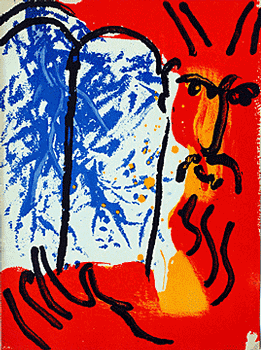featured item
Marc Chagall
Posted by Bob Brooke on 08/06/2017
Learn more aobut Marc Chagall lithographs here today
The Ethereal Biblical Lithographs of Marc Chagall
by Bob Brooke
Since my childhood, [the Bible] has filled me with vision about the fate of the world and inspired me in my work. In moments of doubt, its highly poetic grandeur and wisdom comforted me. For me it is like second nature . . . Since in my inner life the spirit and world of the Bible occupy a large place, I have tried to express it.
—Marc Chagall
Marc Chagall, born in Vitebsk, Belarus, into a traditional Hasidic Jewish family, has been called the quintessential Jewish artist of the 20th century, and one of the foremost visual interpreters of the Bible. He believed that the Bible is the greatest book of poetry of all time. It’s this poetry that he interpreted in his Bible lithographs. He once said that the Bible “is like an echo of nature and this is the secret I’ve tried to transmit.”
Chagall saw sees the biblical narrative from a totally new perspective—through the eyes of a Russian Jew and with deep spiritual insight. His lithographs are intricate and filled with rich color.
His lithographic series, which he called La Bible, took 20 years to complete. The sets of lithographs from 1956 and 1960 are among his most beloved works. Fernand Mourlot printed them and Tériade published special editions of them for Verve magazine.
Chagall opens his 1960 Bible set with a stunning and imaginative depiction of creation. The ethereal blues and the floating images of birds, animals, and angels swirl around a central sun/moon image. Set at an angle to each other, Eve seems to emerge from Adam’s side, recalling the biblical story of the creation of Eve from the rib of Adam.
One of the most fascinating of his lithographs is “Mystical Crucifixion.” Each element in this lithograph contains personal or symbolic meaning for Chagall: a Russian village for the earthly home; a candlestick for the Hebrew Bible, or Judaism; a clock for time, past or present; Madonna and Child for Mary and Jesus, or the relationship of mother and child; a red ox for sacrifice; the Crucifixion for Christ. A prayer shawl covers the loins of Jesus to remind us, lest we forget, that Christ was a Jew. That Chagall, himself a Jew, would have used the Crucifixion in many of his works suggests that he must have understood the event as one of the most poignant symbols of suffering in all of history.
Chagall’s interpretation of Moses shows him surrounded in bright red while clutching the two Tablets of the Law given to him by God.
He interpreted the lithograph, “David with His Harp,” in much the same way, choosing vibrant shades of red, orange, and violet to portray David. He appears intently listening to the quieting music that flows from the instrument. “Whenever the spirit from God came on Saul, David would take up his lyre and play. Then relief would come to Saul; he would feel better, and the evil spirit leave him.” (I Samuel 16:23)
Chagall’s expression of man’s faith in God reaches a climax in his lithograph, “The Sacrifice of Abraham.” Abraham gently holds Isaac’s leg with one hand and lifts the knife with the other. The sudden descent of the angel arrests his movement and Abraham’s submissive eyes lock onto God’s messenger. The small white ram that replaced Isaac as the offering emerges from the dense thicket on the left. In describing his childhood nightmares, Chagall alludes to the frightening imagery of this sacrifice.






